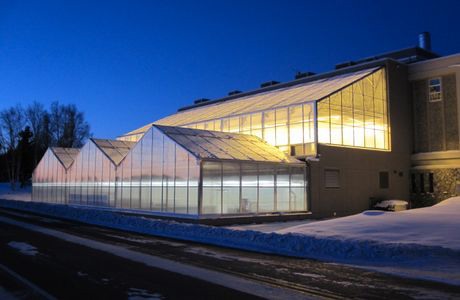Despite some commercial greenhouse activity in Alaska, due to climatic limitations, it tends to be seasonal businesses; and the few year-round producers are restricted to areas where there are natural geothermal springs or other renewable resources - to counteract the extreme temperatures and energy considerations.
In a bid to progress and expand the greenhouse industry within the state, Meriam Karlsson, Professor of Horticulture at UAF, is currently heading up a research project that is piggybacking off the public interest in food security and locally-grown produce (and farmers’ markets); rather than continuing to rely on imports.

In spite of Alaska’s extreme climate (winters can slip to -40, while summers can see temperatures of 80 degrees Fahrenheit – a difference of 120 degrees between seasons…), UAF has built a new multi-purpose, two-level greenhouse on the Fairbanks campus that includes energy shade curtains and fogging systems for cooling.
“It’s getting pretty crowded with parking lots and buildings [on campus] and it turns out the best place was on the south side of an existing building, but there wasn’t a lot of space between the road and the building.
“Because of that we had to do it in two levels and initially I thought that was going to be cumbersome and difficult; but it turned out to be a good solution for us,” said Professor Karlsson.

With the upper level going to be used for teaching and instructional purposes, the bottom or lower level is where the university’s research will be conducted, using High Pressure Sodium lights because the Alaskan days are so short during the winter. But, says, Karlsson, they are looking to invest in LEDs going forward, “because we need to get into something that’s more energy efficient.”
Karlsson and her team have already started researching LEDs and the effects of the spectra during the summer (when there is too much light), and winter, when there is not enough.
“During winter when our days are short, we hardly have any natural light so it’s almost a controlled environment, this is when the LED spectra becomes really important, and we are working on that for different crops, and for our conditions here,” she says.
One Alaskan greenhouse company that has succeeded in producing herbs, lettuce and tomatoes continuously for 12 months of the year is ChenaFresh (touted as the ‘farthest north year-round hypdroponic greenhouse in the US).

ChenaFresh is situated approximately 65 miles north of Fairbanks at Chena Hot Springs Resort, and utilises the naturally occurring geothermal water springs for heating, cooling and electric power within a controlled greenhouse system.
But with companies like ChenaFresh in the minority in Alaska, there’s the added challenge for UAF students hoping to graduate and find employment in the state.
Professor Karlsson is hoping however, that UAF’s greenhouse research into environmental plant physiology and renewable energy sources, will ultimately spur other horti firms to invest in Alaska, and create employment opportunities that will improve the state’s self-sufficiency, and provide jobs for UAF’s horticultural alumni.
One area Professor Karlsson admits they don’t do much research on is seed varieties. “We don’t work a lot on breeding because it’s expensive and it’s hard to get support for that. At the same time there aren’t many [seed breeders] who are interested in developing varieties for our conditions,” she says. “So often we have to look to Canada and the Scandinavian countries for that.”

For more information
University of Alaska
Meriam Karlsson, Professor of Horticulture
[email protected]
www.uaf.edu
